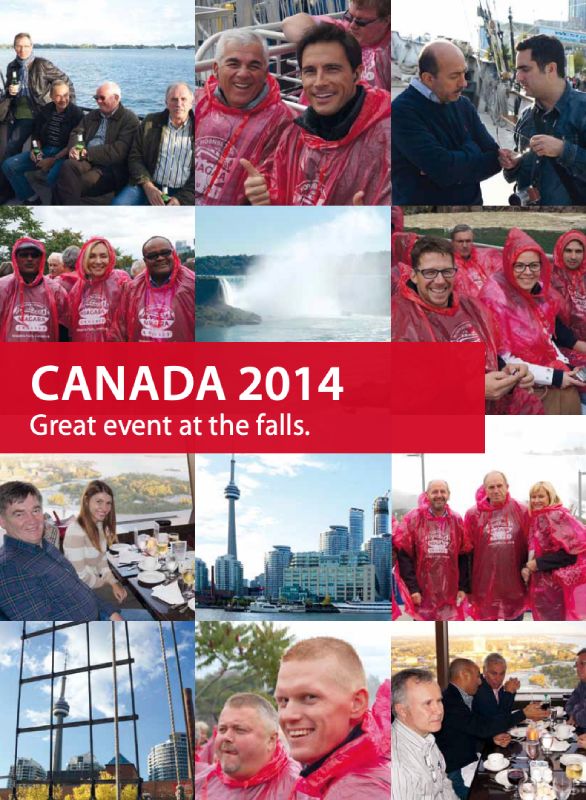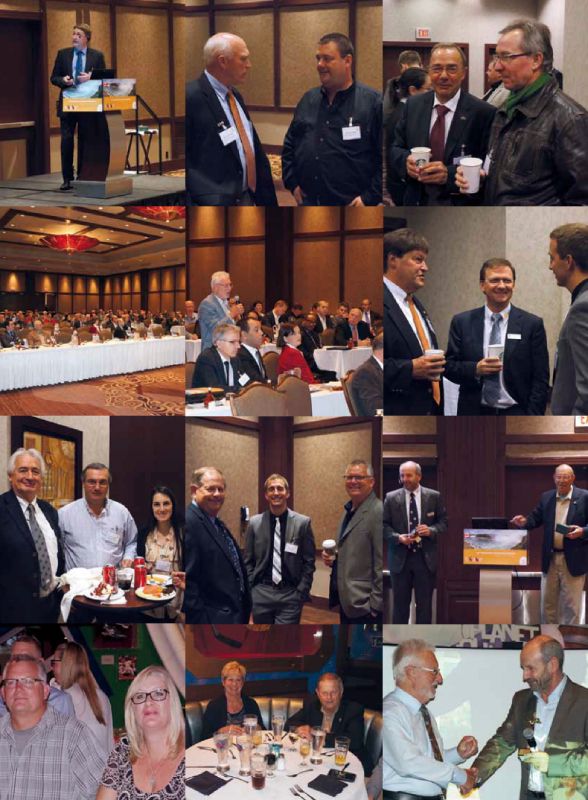Inauguration of the brand new pedigree farm in YORK

From september 22nd – september 24th, LOHMANN TIERZUCHT’s 52nd Franchise Distributor Meeting was held in York, Canada. The official opening of the brand new pedigree farm was the primary reason for the meeting. More than 150 participants from all around the world took advantage of this unique opportunity to have a glance into the daily breeding business of LOHMANN TIERZUCHT and accepted the invitation to North America.
On september 23rd, the event at the world-famous Niagara Falls began with a day of interesting presentations by renowned speakers who covered current topics related to the poultry industry. Mr. Javier Ramirez, Managing Director of LOHMANN TIERZUCHT, opened the event and took the chance to speak proudly about the developing success of the company. There are only 20 remaining countries on the world map where LOHMANN TIERZUCHT has not entered the market, just yet. It is becoming very obvious that there is no doubt in the outstanding quality of LOHMANN TIERZUCHT’s layers. Clever marketing tactics can open up new opportunities for a successful business by the respective distributors. The company is always ready to take on new challenges and is prepared to develop itself and its products further to adapt to new situations in the market. This was emphasized in the interesting presentation held by Prof. Dr. Rudolf Preisinger, Managing Director and Chief Geneticist at LOHMANN TIERZUCHT. with its sophisticated breeding program, the company is able to improve on classic traits like egg number, egg weight and livability to a very high level. These also include traits like beak shape, beak length and nesting behavior, all of which have gained importance in recent years. New breeding methods like genomic selection which has already been well-integrated into the breeding programme at LOHMANN TIERZUCHT for two years now, enable the company to enjoy a much faster breeding progress than ever before.
The presentation held by Mr. Jørgen Kjaer, scientist at Friedrich Löffler Institute, gave an interesting overview on feather-pecking and cannibalism in layers. The scientist has been involved in investigations for a better understanding of the appearance of misbehavior in birds for many years now. He mentioned that through different studies, it is now widely known that feather-pecking and cannibalism are caused by several factors. The focus of prevention should therefore be placed on optimizing layer management. He also mentioned that with a well-organized breeding program, it is possible to select birds with a weaker tendency towards featherpecking. After a series of investigations, he could conclude that hens with a higher drive to feather-pecking and cannibalism are more active and show a higher content of stress hormones, e.g. Corticosterone, in the blood.
 Dr. Hans-Heinrich Thiele and Mr. Farhad Mozafar, both responsible
for Technical service at LOHMANN TIERZUCHT, held a lively debate
on the pros and cons of moulting in layers. Throughout the whole discussion, Dr. Thiele emphasized his opinion that moulting in
modern layer type hens does not make any sense. with an optimized management Lohmann hens show outstanding persistency which makes moulting unnecessary. with examples from the
field, he did some calculations showing that moulting does not
necessarily improve the economic situation of a layer operation.
with opposing views, Mr. Mozafar stated that it is widely known
that moulting can improve the egg shell stability at the end of the
laying cycle and that this improves the number of saleable eggs.
Besides that, moulting reduces the number of male chicks which
is, from an animal welfare point of view, a very valuable argument.
The discussion showed very clearly that there are no real pros and
cons for or against moulting. It is always a question of the situation
of every poultry operation and the market it is operating in.
Dr. Hans-Heinrich Thiele and Mr. Farhad Mozafar, both responsible
for Technical service at LOHMANN TIERZUCHT, held a lively debate
on the pros and cons of moulting in layers. Throughout the whole discussion, Dr. Thiele emphasized his opinion that moulting in
modern layer type hens does not make any sense. with an optimized management Lohmann hens show outstanding persistency which makes moulting unnecessary. with examples from the
field, he did some calculations showing that moulting does not
necessarily improve the economic situation of a layer operation.
with opposing views, Mr. Mozafar stated that it is widely known
that moulting can improve the egg shell stability at the end of the
laying cycle and that this improves the number of saleable eggs.
Besides that, moulting reduces the number of male chicks which
is, from an animal welfare point of view, a very valuable argument.
The discussion showed very clearly that there are no real pros and
cons for or against moulting. It is always a question of the situation
of every poultry operation and the market it is operating in.The “Challenges of today’s layer nutrition” was the theme of Mr. Robert Pottgüter’s presentation, nutritionist at LOHMANN TIERZUCHT. Today, the high demands of soya in the nutrition of animals is being more and more criticized as the cultivation of the same, sometimes result in the deforestation of natural forests in the region of Central and south America. Moreover, in europe, the use of soya in layer diets is controversial in terms of ongoing GMO discussions. In order to escape this dispute and to counter the high soya prices, questions are constantly being posed about soya-free and/or soya reduced diets. In his presentation, the experienced nutritionist expressed that there are indeed alternatives to soya in layer rations, e.g. rape and sunflower. It is, however, of great importance to take the quality of these raw materials into account so as to avoid having a negative impact on the performance of the birds. Investigations in practical trials have to be performed in order to determine to which extent soya can be excluded in layer feed. If soya would be reduced, then the application of synthetic amino acids in the feed is of main significance.
“The use of organic acids in the layer husbandry” was the subject presented by selko Feed Additives’ Mr. Christian Lienesch. It is becoming more and more important to reduce the application of medication in layer husbandry or better still, to do away with it completely. Applying organic acids in the feed or drinking water can help to improve gut health in layers, thereby improving their resistibility towards pathogenic agents. Mr. Lienesch mentioned that although there are many different acids that can be used, one has to take into account that they each have a different effect on various pathogenic agents. some are useful against e.Coli and salmonella whereas others are effective in treating mold and yeast. It is therefore necessary to investigate the situation at every farm very closely before choosing a suitable acid.
The last presentation of Prof. Paul siegel, Virginia Tech University, covered the development of the poultry industry. In his lively presentation, he illustrated how humans managed to domesticate the original Red Jungle-fowl (Bankiva) to the modern laying hen. The experienced scientist stated that aside from the chickens themselves, which are the base of a poultry breeding company, it is actually the people who are working within a company which are of great importance to guaranteeing the success of any breeding company.
On wednesday, the 24th of september, the grand opening of the pedigree farm was celebrated. with an official ribbon-cutting ceremony, both managing directors, Prof. Dr. Rudolf Preisinger and Mr. Javier Ramírez, opened the doors of the farm for a wellorganized tour. Divided into groups, the visitors were allowed to explore the farm by visiting different stations within the building. This gave a very good overview about the quality of the building and familiarized the visitors with the breeding programme at LOHMANN TIERZUCHT. At eight different stations, each visitor was given a detailed explanation on how different traits are measured at farm level, i.e. before the values of the same are entered into a database. This allows the geneticist to derive conclusions on the breeding values of every chick. Demonstrations on how artificial insemination is done in pure line hens were carried out at one station. The visitors got an idea of how accurate the laying performance and the egg weight of each single hen are determined. Much attention was drawn by the egg quality station. Here, there was a demonstration on how the breaking strength of eggs is recorded. Not only is the “output” of the hens (the eggs and their quality) of main interest for the respective geneticist, but also the “input” is of crucial importance. Of course, it is relevant how much feed the hens need to produce eggs; this is precisely recorded for every hen in different phases of their lives. The results have an influence on the breeding value of every hen. The guided tour of the breeding farm and the well-organized explanations at the different stations made the visitors aware of the complexity of LOHMANN TIERZUCHT’s breeding program.
The program was enhanced by diversified leisure activities. A boat trip going literally into the Niagara Falls and an excursion to a historic village of native Indians at “Crawford Lake” enabled the visitors to get in touch with the incredible nature of Canada and its native culture. During a trip to the vineyard “Jackson Triggs”, guests could taste the quality of the regionally produced wines. The leisure program offered the perfect opportunity for visitors to interact with each other and share valuable information and experiences in relation to their businesses.
Article: Djanet Ould-Ali
Photos: Stella Schnor













